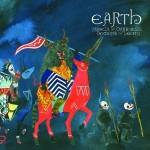
Earth Angels of Darkness, Demons of Light II
(Southern Lord)
Earth-song has always existed in geological time. With their epochal debut, Earth 2: Special Low-Frequency Version, in 1993 they pretty much invented an entire sub-genre, variously known as drone metal, drone doom, or power ambient, although labels such as these exist only to simplify and reduce. With their subsequent two albums, Phase 3: Thrones and Dominions (1995) and Pentastar: In the Style of Demons (1996) they explored the relationship between traditional metal, with its reliance on structure and the riff, and avant-garde noise, where duration, drone and texture take precedence. Following the latter there followed a well-documented hiatus due to Dylan Carlson’s various ‘issues’, after which they reappeared in 2005 with Hex; or Printing in the Infernal Method which featured a change of approach for the band. Gone were the distortion and volume, to be replaced by a more acute appreciation of dynamics and alternative instrumentation. The slothful pace and length of the songs still remained, but now with a wider range of influences from country, blues and (especially) English folk. February 2011 saw the release of Angels of Darkness, Demons of Light I. This saw a partial return to the aggressiveness of their early sound, but Lori Goldston's cello provided a mournful, plaintive foil to Dylan Carlson’s widescreen desert-blues guitar. The album was spellbindingly beautiful, and offered a freshly folkloric take on the old weird America.
Angels of Darkness, Demons of Light II is not so much a follow-up as a companion piece, being conceived and recorded in the same two-week session as the first record, despite being released a year later. It is more improvisatory than its predecessor, more freeform and drifting, less reliant on structure and riffage. The album opens with Sigil of Brass, a short introductory piece for solo guitar, augmented only by some subtle cymbal washes that colour the silences behind the notes. The simple, repeated guitar motif is gentle, almost lulling as if Carlson is scoping the ground ahead. His Teeth Did Brightly Shine is an alt.folk chamber piece recalling 1960s psychedelia, while the epic A Multiplicity of Doors lies at the album’s core, with Adrienne Davies’ controlled yet expressive drums featuring prominently for the first time on the album. Goldston’s cello here takes equal billing to Carlson’s lead guitar, lending a sinister low-end growl. With its slow, languid groove and that cello providing a compelling undertow it most immediately recalls The Pink Room, from Angelo Badalamenti’s Twin Peaks: Fire Walk with Me soundtrack (a track that accompanies a terrifying scene in the film – “I am the Great Went…”). The kind of unease with which David Lynch imbues his films is translated into musical form by Earth – an apparently simple narrative loaded with suggestion, shadow and malignance. On The Corascene Dog the interplay between the four musicians is especially focused (bassist Karl Blau being the forth corner of the square) – the group sound intuitively linked as all great groups do, especially ones that rely on a degree of improvisation, tight yet relaxed. The final track The Rakehell is perhaps the most surprising on the album, with a slo-mo groove of Funakdelic proportions, its languor being a perfect embodiment of the louche, amoral cad of the title.
Throughout this extraordinary album, what consistently impresses most is the mesmerizing atmosphere created by these musicians. The musical star is drummer Adrienne Davies, whose subtle and supple percussion perfectly underpins and propels these tracks. The slowest of songs always present a challenge to the drummer: how to keep time without a) getting bored out of your skull or b) filling the track with unnecessary and inappropriate fills. Davies manages this balancing act perfectly. Her contributions are brilliantly judged – almost jazz-like in places – not flashy but consummate and intelligent.
Overall, this album contains some of the most original and hypnotically brilliant rock music ever recorded. Moments of light are allowed to shine into the gloom that earlier Earth albums groaned under the weight of. These moments add a more human dimension to the music, but the darkness is still ever-present, pervasive and insidious. The music exists in a timeless space – invoking ancient ritual and ceremony – like the American West as described by Cormac McCarthy, at odds with the modern world. The more eagle-eyed among you will have noticed a rare 10 out of 10 rating at the top of the page. This comes with a proviso. The album works best when listened to and appreciated in the same light as Angels I, as the two complement each other in a yin/yang relationship, much in the same way as Radiohead’s Kid A/Amnesiac diptych. They need and deserve to be regarded as a single piece of work. As such they represent not only a flowering (in the desert) of Earth’s singular aesthetic, but one of American rock music’s greatest ever statements.
5 March, 2012 - 18:50 — David John Wood